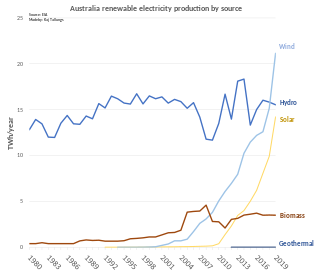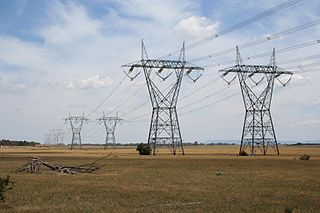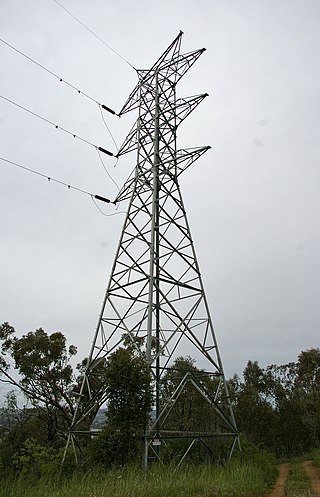
CLP Group and its holding company, CLP Holdings Ltd, also known as China Light and Power Company, Limited, is an electricity company in Hong Kong. Incorporated in 1901 as China Light & Power Company Syndicate, its core business remains the generation, transmission, and retailing of electricity. It also has businesses in a number of Asian markets as well as EnergyAustralia in Australia. It is one of the two main electricity power generation companies in Hong Kong, the other being Hongkong Electric Company.

EnergyAustralia was a state–owned enterprise of the Government of New South Wales, Australia. It was electricity and gas supplier and retailer which primarily supplied the Sydney, Newcastle and Central Coast areas of New South Wales. Since market deregulation, it increased its focus on retail supply opportunities in electricity and gas to the Victorian market and electricity in the deregulated south–east corner of Queensland.

The Yallourn Power Station, now owned by EnergyAustralia a wholly owned subsidiary of the Hong-Kong-based CLP Group, is located in the Latrobe Valley of Victoria, Australia, beside the Latrobe River, with the company town of Yallourn located to the south west. Yallourn PS was a complex of six brown coal–fired thermal power stations built progressively from the 1920s to the 1960s; all except one have now been decommissioned. Today, only the 1,450 megawatts (1,940,000 hp) Yallourn W plant remains. It is the second largest power station in Victoria, supplying 22% of Victoria's electricity and 8% of the National Electricity Market. The adjacent open cut brown coal mine is the largest open cut coal mine in Australia, with reserves sufficient to meet the projected needs of the power station to 2028. On 10 March 2021, EnergyAustralia announced that it will close the Yallourn Power Station in mid-2028, four years ahead of schedule, and instead build a 350 megawatt battery in the Latrobe Valley by the end of 2026. At the time, Yallourn produced about 20% of Victoria's electricity.

The State Electricity Commission of Victoria is a government-owned renewable electricity investment enterprise in Victoria, Australia. Originally a major energy supplier in the state, the SEC was privatised in the 1990s before being revived in 2023 to invest in renewable energy and storage.

Origin Energy Ltd is an ASX listed public company with headquarters in Sydney. It is a major integrated electricity generator, and electricity and natural gas retailer. It operates Eraring Power Station, Australia’s largest coal-fired power station, in New South Wales, which it plans to close in 2025. In 2022, it was Australia's fourth largest climate polluter. It owns 20% of Octopus Energy, a UK renewable energy retailer, a stake potentially worth billions of dollars.
Mount Piper Power Station is a coal powered power station with two steam turbines with a combined generating capacity of 1,400 MW of electricity. It is located near Portland, in the Central West of New South Wales, Australia and owned by EnergyAustralia, a subsidiary of CLP Group. On 23 September 2021, it was announced that the closure of the power station is being brought forward from 2042 to 2040 at the latest. The power station employs 250 workers.

Wallerawang Power Station was a thermal coal power station, located near Wallerawang, in the Central Tablelands region of New South Wales, Australia. The power station was equipped with two turbo-alternators of 500 megawatts (670,000 hp) each, supplied by CA Parsons and Company of Newcastle-upon-Tyne, England. Production commenced in May 1957.
E.ON UK is a British energy company and one of the largest suppliers of energy in the UK, following its acquisition of Npower. It is a subsidiary of E.ON of Germany and one of the Big Six energy suppliers. It was founded in 1989 as Powergen, and was listed on the London Stock Exchange and was once a constituent of the FTSE 100 Index. It has been a subsidiary of E.ON since 1 July 2002.

The Energy Brix Power Station was a brown coal–fired thermal power station located at Morwell, in Victoria, Australia. The power station was used to supply electricity for the retail market, as well as the production of briquettes in the adjacent Energy Brix briquette works. It was shut down in August 2014 and is currently the earliest surviving large-scale power station designed to provide electricity to the state electricity network.

Delta Electricity is an electricity generation company in Australia. The company was formed by the Government of New South Wales in 1996 as part of its reform of the electricity sector in the State, which saw the breakup of the Electricity Commission of New South Wales. Delta Electricity, which at the time owned only the Vales Point Power Station, was sold to Sunset Power International for $1 million in November 2015 and was valued at $730 million 2 years later. It has a portfolio of generating sites mainly using thermal coal power.
The energy policy of India is to increase the locally produced energy in India and reduce energy poverty, with more focus on developing alternative sources of energy, particularly nuclear, solar and wind energy. Net energy import dependency was 40.9% in 2021-22.

AGL Energy Ltd is an Australian listed public company involved in both the generation and retailing of electricity and gas for residential and commercial use. AGL is Australia's largest electricity generator, and the nation's largest carbon emitter. In 2022, 83% of its energy came from burning coal. It produces more emissions as a single company than the nations of New Zealand, Portugal or Sweden, according to its largest shareholder, Mike Cannon-Brookes, who named it "one of the most toxic companies on the planet".

The energy policy of Australia is subject to the regulatory and fiscal influence of all three levels of government in Australia, although only the State and Federal levels determine policy for primary industries such as coal. Federal policies for energy in Australia continue to support the coal mining and natural gas industries through subsidies for fossil fuel use and production. Australia is the 10th most coal-dependent country in the world. Coal and natural gas, along with oil-based products, are currently the primary sources of Australian energy usage and the coal industry produces over 30% of Australia's total greenhouse gas emissions. In 2018 Australia was the 8th highest emitter of greenhouse gases per capita in the world.

Renewable energy in Australia includes wind power, hydroelectricity, solar photovoltaics, heat pumps, geothermal, wave and solar thermal energy.

Energy in Victoria, Australia is generated using a number of fuels or technologies, including coal, natural gas and renewable energy sources. Brown coal, historically, was the main primary energy source for the generation of electricity in the state, accounting for about 85% of electricity generation in 2008. The amount of coal-fired power has decreased significantly with the closure in 2017 of the Hazelwood power station which supplied around 20% of Victoria's electricity, and to a lesser extent with the exit of Anglesea power station in 2015. Brown coal is one of the largest contributors to Australia's total domestic greenhouse gas emissions and a source of controversy for the country. Australia is one of the highest polluters of greenhouse gas per capita in the world.

The Electricity Commission of New South Wales, sometimes called Elcom, was a statutory authority responsible for electricity generation and its bulk transmission throughout New South Wales, Australia. The commission was established on 22 May 1950 by the Electricity Commission Act 1950 to take control of power generation in the State. The commission acquired the power stations and main transmission lines of the four major supply authorities: Southern Electricity Supply, Sydney County Council, the Department of Railways and the Electric Light and Power Supply Corporation Ltd, also known as the Balmain Electric Light Company, the owner and operator of Balmain Power Station. The commission was responsible for the centralised co-ordination of electricity generation and transmission in the State, and some local councils continued to be distributors of electricity only.

Greenhouse gas emissions by Australia totalled 533 million tonnes CO2-equivalent based on greenhouse gas national inventory report data for 2019; representing per capita CO2e emissions of 21 tons, three times the global average. Coal was responsible for 30% of emissions. The national Greenhouse Gas Inventory estimates for the year to March 2021 were 494.2 million tonnes, which is 27.8 million tonnes, or 5.3%, lower than the previous year. It is 20.8% lower than in 2005. According to the government, the result reflects the decrease in transport emissions due to COVID-19 pandemic restrictions, reduced fugitive emissions, and reductions in emissions from electricity; however, there were increased greenhouse gas emissions from the land and agriculture sectors.

Energy in Australia is the production in Australia of energy and electricity, for consumption or export. Energy policy of Australia describes the politics of Australia as it relates to energy.

OVO Energy is a major energy supplier based in Bristol, England.
Shell Energy Australia provides gas, electricity, environmental products and energy productivity services to commercial and industrial customers.
















